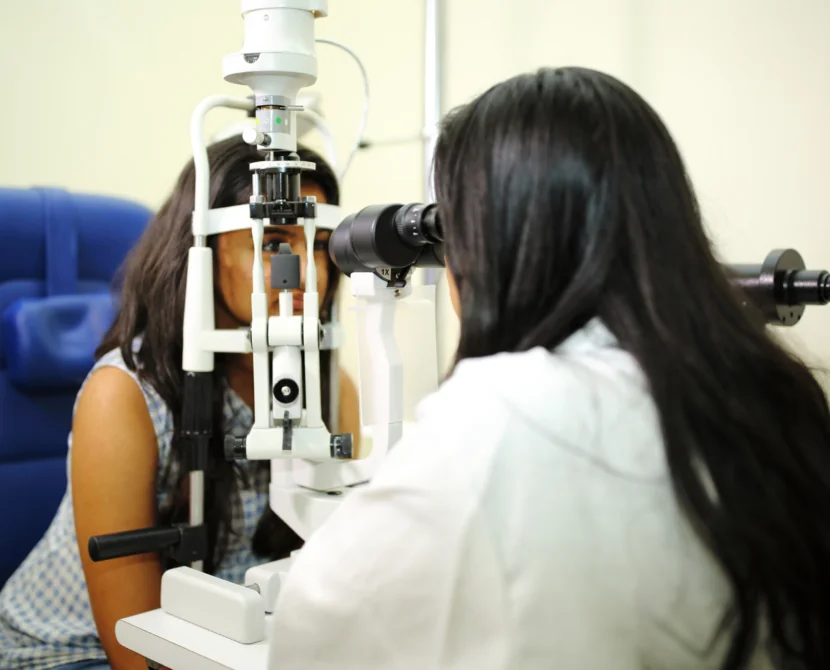How to Prevent Eye Damage from Diabetes (and Protect Vision!)

What can you do to keep your eyes healthy and prevent vision loss? The key steps are listed here. In this article, we will focus on developing a healthy lifestyle as a key factor in protecting your vision.
- Get a dilated eye exam at least once a year to detect any problems early when treatment will be most effective.
- Be alert to any vision changes and contact your eye care professional as needed.
- Develop a healthy lifestyle. This includes eating healthy and being active.
- Keep your blood sugar levels, blood pressure and blood cholesterol (lipid) levels in your target range as much as possible, including taking medications as prescribed.
- If you smoke, quit smoking.
Eating healthy. If you are looking for an eating plan that is healthy for your eyes, good news! It turns out that the same eating plan that helps your diabetes and your heart will also help your eyes. The focus is on what you can (should) eat instead of what you should not eat! Overall, an eating pattern rich in plant-based foods and low in animal fats and saturated fats is best.
What is the Mediterranean diet?
The Mediterranean eating pattern, so named after the eating habits of those living near the Mediterranean Sea is often recommended. Researchers report this plant and seafood-based eating pattern may not only help reduce your risk of heart disease but also reduce your risk of diabetes-related eye disease. Researchers found lower rates of macular degeneration among people who ate more vegetables, beans, fish, cereals, and especially fruits. On the other hand, people who had macular degeneration ate more fast food, ready-made meals, and meat compared with people who did not have macular degeneration.
Studies have also found that women who ate fish high in omega-3 fatty acids at least twice a week were less likely to get age-related macular degeneration. Fish is also good for your heart. The American Heart Association recommends that healthy adults eat fish at least twice a week. Some fish contain high mercury levels and should be eaten sparingly or avoided completely during pregnancy.
The Mediterranean eating pattern includes:
- Colorful vegetables and fruits
- Nuts such as almonds, cashews, and walnuts
- Seafood as your primary meat source
- Healthy fats like olive oil instead of butter
- Whole grain bread, cereals, and pasta
- Plenty of herbs and spices added to your food to lower your salt intake and add nutrients
- Moderate amount of yogurt, cheese, and eggs
When deciding what to eat, consider the impact your food choices and portion sizes have on your blood glucose. Monitoring glucose before and 1-2 hours after eating will help you learn how your body responds to your usual meals and snacks. A general recommendation to help with portion sizes is to fill one half of your plate with non-starchy vegetables, one quarter with a lean protein choice such as seafood and the final quarter with a whole grain. A serving of fruit and possibly low-fat dairy on the side completes the meal. Here is a diagram from the American Diabetes Association to help in planning your plate.
[Include the pie chart infographic from the American Diabetes Association.]
What is the best food for eye health?
Foods rich in vitamins A, C and E, selenium, zinc, antioxidants such as lutein and zeaxanthin, and omega-3 fatty acids have been linked to lower risks of diabetes-related eye conditions. Think about ways you can include a rainbow of healthy plant foods on your plate every meal and at snacks.
Foods to eat to keep your eyes healthy
| Nutrient | Food sources | How it helps |
| Vitamin A | Orange vegetables and fruits such as carrots, sweet potatoes, cantaloupe and apricots | Vitamin A helps the retina turn light rays into the images we see; helps prevent dry eye. |
| Vitamin C | Oranges, grapefruit, kiwifruit, strawberries, tomatoes, red and green peppers, and broccoli. Dark green, leafy vegetables such as kale and spinach | Wheat, rice, oats, barley, rye, and quinoa are rich in selenium. |
| Vitamin E | Almonds, cashews, pistachios, walnuts, sunflower seeds, olive oil, and avocados. | Antioxidants, like Vitamin E help fight free radicals, which damage tissues throughout the body. Sometimes, free radicals may damage proteins within the eye. This damage can result in the development of cataracts on the lens of the eye. |
| Selenium | Wheat, rice, oats, barley, rye, quinoa are rich in selenium. | Selenium is an essential mineral that plays a vital role in maintaining overall health and wellness including eye health. Selenium contributes to eye health by acting as an antioxidant. Selenium helps to neutralize free radicals, preventing them from causing harm to the eyes. |
| Zinc | Beans, lentils, seeds, lean red meat, poultry, seafood, oysters, dairy, eggs, and fortified cereals | Zinc helps keep the retina healthy and may protect your eyes from the damaging effects of light. |
| Lutein and zeaxanthin | Leafy green vegetables like kale, collards, spinach, turnip greens and Swiss chard. Other rich sources include broccoli, asparagus, romaine lettuce, peas, and colorful fruits like raspberries, papaya, peaches, and mangoes. Eggs also are a good source of these nutrients. | Both lutein and zeaxanthin are found naturally in the retina, the light sensitive tissue lining the back of the eye. They are key to eye health including protecting the macula, the area of the eye that gives us our central, most detailed vision. They may also help reduce the risk of developing cataracts. The antioxidants in these foods keep us healthy by delaying or slowing down oxidation, which causes aging or cell death. Oxidation may lead to cataracts by causing changes to fats and proteins in the eye lens, making the lens cloudy. |
| Omega-3 fatty acids | Cold-water fish such as halibut, herring, mackerel, salmon, sardines, tuna, trout | Diets rich in omega-3 fatty acids from cold-water fish may help reduce the risk of developing eye disease later in life; may help prevent dry eye. |
Should I be taking vitamins and minerals?
While you can get supplements in pill form, antioxidants are most beneficial from fruits and vegetables and other whole foods. Studies show that antioxidant supplements do not help prevent cataracts. Supplements may even be harmful. For example, high-dose beta-carotene supplements have been shown to increase risk of lung cancer in smokers and former smokers. High-dose vitamin E supplements increase risk of hemorrhagic stroke (stroke caused by bleeding in the brain) and prostate cancer. Filling up the plate with a variety of whole, plant-based foods is the best way to get eye-healthy nutrients instead of relying on supplements.
People who have macular degeneration are an exception. In this case, taking supplements is recommended by the Age-Related Eye Disease Study 2, a follow-up to the Age-Related Eye Disease (ARED) Study. See the article on Diabetes Macular Edema to learn more.
Physical activity. Engaging in more physical activity has been shown to delay the onset and progression of diabetes-related retinopathy, protecting the retina and reducing inflammation. The Centers for Disease Control and Prevention, the World Health Organization and the American Heart Association all recommend 150 minutes of moderate aerobic exercise per week. That’s equivalent to about 30 minutes per day, five days per week. This can include walking, cycling, swimming, dancing and even active gardening. Consistent physical activity can help you and your eyes stay healthy. However, be sure to discuss all new exercise and physical activity routines with your doctor beforehand, particularly if you already have diabetes-related retinopathy.
No smoking. Smoking is harmful for your overall health, and also for your eyes. Cigarette smoking is linked to many eye diseases, including cataracts and macular degeneration. Since even secondhand smoke can be harmful to the eyes, try your best to avoid it. For help quitting visit the CDC website for a wealth of resources.
Transform your diet today. Your eyes will thank you later.
Pick an eye-healthy food from the table above that is new to you to try this week. No matter your age, it’s not too late to begin to step-by-step build a healthy lifestyle. Any action you take now will benefit your vision and your health for the rest of your life.
References:
AlQabandi Y, Nandula SA, Boddepalli CS, Gutlapalli SD, Lavu VK, Abdelwahab Mohamed Abdelwahab R, Huang R, Potla S, Bhalla S, Hamid P. Physical Activity Status and Diabetic Retinopathy: A Review. Cureus. 2022 Aug 21;14(8):e28238. doi: 10.7759/cureus.28238. PMID: 36158437; PMCID: PMC9491630.
Claudia Louro Farinha, Filipe Mira, Lèlita Santos, Sandrina Nunes, Ana Pedroso, Inês Laíns, Maria Luz Cachulo, Rufino Silva; Nutritional and lifestyle risk factors in AMD. The Coimbra Eye Study. Invest. Ophthalmol. Vis. Sci. 2015;56(7 ):3770.
Hogg RE, Woodside JV, McGrath A, et al. Mediterranean diet score and its association with age-related macular degeneration. The European Eye Study. Ophthalmology. 2017;124(1):82-89.
Lawrenson JG, Downie LE. Nutrition and eye health. Nutrients. 2019;11:2123.
Merle B, Benlian P, Puche N, et al. Circulating Omega-3 Fatty Acids and Neovascular Age-Related Macular Degeneration. Investigative Ophthalmology & Visual Science 2014;55(3), DOI:10.1167/iovs.14-13916
https://professional.diabetes.org/sites/dpro/files/2023-12/plan_your_plate.pdf
Written by






